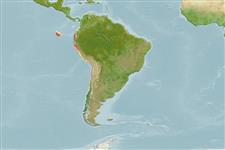Issue
Probably a junior synonym of Tetronarce tremens according to Carvalho et al., 2002 in Weigmann, 2016 (Ref. 106604).
Environment: milieu / climate zone / depth range / distribution range
Ecologia
marinhas associadas(os) a recifes; intervalo de profundidade 24 - 168 m (Ref. 12951). Tropical
Southeast Pacific: Peru and the Galapagos Islands (Ref. 12951); including Colombia (Ref. 58465).
Tamanho / Peso / Idade
Maturity: Lm ? range ? - ? cm
Max length : 50.0 cm TL macho/indeterminado; (Ref. 12951)
A semi-pelagic ray found on sand and mud bottoms as well as in the water column over deep water. Ovoviviparous (Ref. 50449).
Life cycle and mating behavior
Maturidade | Reprodução | Desova | Ovos | Fecundidade | Larvas
Exhibit ovoviparity (aplacental viviparity), with embryos feeding initially on yolk, then receiving additional nourishment from the mother by indirect absorption of uterine fluid enriched with mucus, fat or protein through specialised structures (Ref. 50449).
Michael, S.W., 1993. Reef sharks and rays of the world. A guide to their identification, behavior, and ecology. Sea Challengers, Monterey, California. 107 p. (Ref. 12951)
Categoria na Lista Vermelha da IUCN (Ref. 130435: Version 2024-1)
Ameaça para o homem
Harmless
Utilização humana
Ferramentas
Relatórios especiais
Descarregue XML
Fontes da internet
Estimates based on models
Preferred temperature (Ref.
123201): 13.3 - 16.9, mean 15.3 °C (based on 12 cells).
Phylogenetic diversity index (Ref.
82804): PD
50 = 0.5001 [Uniqueness, from 0.5 = low to 2.0 = high].
Bayesian length-weight: a=0.01479 (0.00665 - 0.03288), b=2.96 (2.77 - 3.15), in cm total length, based on LWR estimates for this (Sub)family-body shape (Ref.
93245).
Nível Trófico (Ref.
69278): 4.1 ±0.6 se; based on size and trophs of closest relatives
Resiliência (Ref.
120179): Baixo, tempo mínimo de duplicação da população 4,5 - 14 anos (Preliminary K or Fecundity.).
Fishing Vulnerability (Ref.
59153): Moderate vulnerability (40 of 100).
